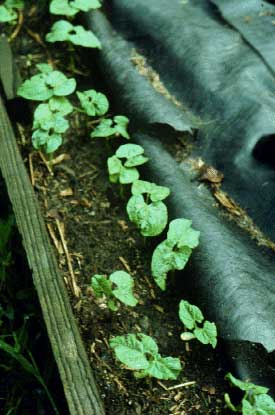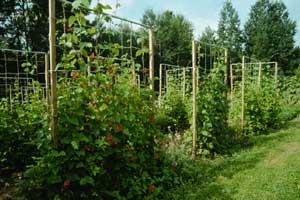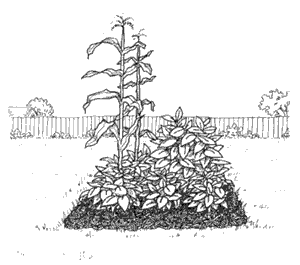How Many To Plant
How many seeds to plant depends on the type of beans you grow and how much the members of your family like them. Plant roughly 3 to 5 hills of pole beans or 10 to 15 bush beans per family member. A 25-foot row of pole beans yields 50 to 70 pounds of beans. The same 25 foot row of bush plants will yield 20 to 30 pounds of beans. A 100 foot of row of bush beans will provide 50 quarts of beans for freezing or canning.
Remember that for bush type beans there is no need to plant all the seeds in the packet at the same time. In fact it is a good idea to time plantings 2 weeks apart so that the harvest is staggered over the summer and you are not innundated with all of the crop at once.
How To Plant Snap Beans
 |
Plant bush type bean seeds directly into the garden bed or container. Plant them 1 inch deep in heavy soils, 1-1/2 inches deep in light soils. Space bush varieties 3 to 4 inches apart in a row, and space the rows at least 18 inches apart. If space is limited, closer spacing is no problem. In fact, dense planting shades the soil, which helps retain moisture and discourage weeds.
Plant pole type bean seeds about 3 to 6 inches apart, in rows at least 24 inches apart. An alternative is to plant them in hills--3 or 4 seeds to a hill--around a stake or tepee made of several stakes. Do not presoak bean seeds--they’re liable to rot. In fact, in humid parts of the country such as the East, buy new seeds every year to assure no rot has set in.
Bush beans are ready to pick in about 55 days. Pole beans may take a little longer, but they continue to produce for the rest of the season as long as you keep picking the mature beans. To harvest bush beans all season long, plant seeds every 10 days or so up to 2 months before the expected first frost.
Bean Seed Inoculant
An inoculant is a highly effective form of Rhizobia bacteria that, when placed in close proximity to a legume seed at planting, stimulates the formation of nitrogen-bearing "nodules" on the roots. Common legumes are: garden beans, garden peas, fava beans, soybeans, and lentils. When tilled in following seasonal maturity and returned to the soil, these nodules add readily and easily assimilable nitrogen. Inoculation is a low-cost way to ensure nodulation in an environmentally safe manner
Amendments In Planting or Transplanting
There are a number of products at the garden center that will help your newly planted or transplanted plants deal better with the stress inherent in the planting process. All healthy plants have beneficial fungi, called mycorrhizal fungi, living on their roots. You can buy these valuable additions to your plant’s ecosystem. See the file describing Using Micorrhizae When Planting.
In addition, there are a number of products such as seaweed, compost tea, and beneficial soil microbes that when added to the planting process will help your newly established plants get going faster. See the file New Technology In Plant Growth Activators
Where to Plant Snap Beans
Choose a site that gets full sun. Because snap beans are warm weather plants, be very sure all danger of frost is past before sowing seed. Young plants are very sensitive to frost, and a late frost will kill them. The soil must be warm enough to start--snap bean seeds will not even germinate until the soil temperature is at least 60° F, regardless of the air temperature. The best soil temperature for germination is 70 to 80° F. To warm soil up more quickly, lay a sheet of black plastic over the area to be planted a few weeks beforehand. Plant seeds through small holes cut in the plastic. This will allow rain water to get into the soil.
Snap beans aren’t very fussy about soil. They grow in a wide variety of soil types, preferring them to be slightly acidic (pH 5.8 to 6.5) and well-draining. To improve drainage of heavy soils or clay, dig down several inches and mix in chopped leaves, peat moss 6 75 100 or other organic material. If the soil is not compacted, snap bean roots will penetrate 36 to 48 inches down.
Support for Pole Beans
 |
Pole beans require support. Set them up prior to planting so you do not disturb the roots of the growing plants. Use sturdy stakes, at least 8 feet tall or a stout trellis. If you grow pole beans, we recommend growing them vertically on a trellis rig of some sort. Trellises offer two great advantages over letting the plants just sprawl all over the place: One, they save lots of garden space, and Two, you’ll get more beans. The bean pods hang down and tend to be longer and straighter and they have fewer disease and insect problems. The best rule is to set up your trellis before you plant your beans. You can train the plants up vertical stakes, a meshwork design, an A- frame, whatever works to support the plants. The trellis should be at least 6 feet tall. Wide trellis netting 6 78 400A allows you to pick beans from both sides of the trellis.
Establish one stake per hill of pole bean plants, or use several stakes lashed together at the top as a teepee for support of many plants. Pound all stakes or trellis supports at least a foot into the soil. Fasten nylon mesh netting or garden twine to make a trellis, or lash poles together for a “teepee.” When the tender young vines are tall enough, coax them onto their support by twining their growing tips clockwise around the netting or stake.
Interplanting Snap Beans
 |
| Beans are often planted in amongst corn. The corn becomes the trellis |
Snap beans are comfortable just about anywhere--besides the vegetable bed, bush beans can go in among other garden plants such as corn, or even among ornamental plants such as peonies, daylilies or small shrubs. Pole beans can be planted among other vining plants.
How About Snap Beans In Containers?
Snap beans will grow in planters and other containers. These should be at least 8 inches wide and 8 to 10 inches deep. Pole beans will need a support in the container. Use a soilless mix and make sure the container soil never dries out.
The best varieties of snap beans for containers are:
‘Bush Romano,’
‘Contender,’
‘Tendercrop Stringless.’
Other bush types worth trying include:
Bush (green) Burpee's Tenderpod,
Blue Lake,
Bush Roman [Italian],
Greencrop,
Tenderpick Bean
Roma II (yellow)
Goldcrop Wax Bean,
Rocdor;
Royal Burgundy(purple)
Royalty Purple Pod.
Pole varieties for containers include:
Kentucky Wonder (green)
Kentucky Blue
Romano [Italian]
Frima(yellow)
Jeminez(purple).

